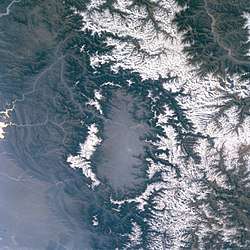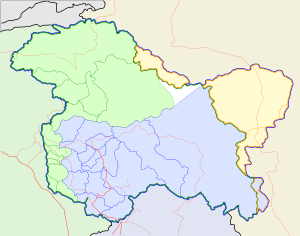Khasas
Khasas (Devanāgarī: खश; Khaśa) were an ancient Bahliki speaking Indo-Aryan tribes. They were mentioned in the various historical Indian inscriptions and ancient Indian and Tibetan literatures. They were native Indic peoples who were reported to have lived around Gandhara, Trigarta and Madra Kingdom in the northern Indian subcontinent.

Descendants of this tribe includes Khas people of medieval Western Nepal, medieval Indian regions of Garhwal and Kumaon and Himachal zone as well as Khakha Rajputs of Kashmir.
Names and variants
The original spelling for the name in Sanskrit literature is Khaśa (Sanskrit: खश) while variants of name also used are Khasa (खस), Khaṣa (खष) and Khaśīra (खशीर).[1]
Indian sources
Pre-historic literature
The Manusmriti states that the Khasas and several other tribes like the Sakas, Yavanas, Kambojas, Paradas, Daradas, Pahlavas, etc. were originally noble Kshatriyas, but later, due to their non-observance of valorous Kshatriya codes and neglect of chivalry, they had gradually sunken to the status of Mlechchas.[2] Thus, it describes them as descendants of outcast Kshatriyas.[3] The Bhagavata Purana describes them as a previously outcast group who redeemed themselves by adopting Vaishnavism.[3] The Mahabharata mentions the Khasas as one of the northern tribes who fought on the side of the Kaurava against Satyaki.[4] In the Karna Parva of Mahabharata, Khasas are mentioned living in the Panjab region between Āraṭṭa and Vasāti:
prasthalā Madra-Gandhāra Āraṭṭa nāmatah Khaśāh Vasāti Sindhu-sauvīrā[1]
In the Sabhaparvan of the Mahabharata, they are mentioned between Meru and Mandara along with Kulindas and Tanganas.[5] In Dronaparvan of the Mahabharata, they are mentioned with other northwestern tribes such as Daradas, Tanganas, Lampakas and Kulindas.[3] The Vaishnava text Harivamsa describes that the Khasas were defeated by the King Sagara.[6][3] The Markandeya Purana states that the Khasa is a country against the mountain. The Markandeya Purana, Vayu Purana and Kalki Purana describes that Khasas together with Sakas and other tribes have penetrated to the northwest of India.[3] The Skanda Purana mentions the region of Himachal Pradesh and Kumaon-Garhwal as Kedare-Khasa-Mandale.[7]
Medieval literature

The Brihat Samhita authored by Indian polymath Varāhamihira grouped Khasas with Kulutas, Kashmiras, Tanganas, and Kunatas.[3] The Mudrarakshasa of Indian poet Vishakhadatta mentions that Khasas and Magadhas were Ganas (troops) in the army of Rakshasa and Malayaketu.[3] According to an ancient Kashmiri text Nilamata Purana compiled by Indian scholar Ved Kumari Ghai, the Khasa tribe occupied
"the valley to the south and west of the Pir Pantsal range between the middle course of the Vitasta (modern Jhelum river) in the west and Kastavata (modern Kishtwar) in the east."[8][9]
This assertion is also corroborated by the later 12th century text Rajatarangini translated by British archaeologist Sir Marc Aurel Stein.[6] The Bharata Nātyaśāstra by the Indian musicologist Bharata Muni mentions that the mother tongue language of Khaśas was Bāhliki language in the phrase
"Bāhlikabhāśodhīchyanāṃ Khaśāṇāṃ ca svadeśajā." (Translation : The Bahliki language is the native tongue of the Northerners and Khasas.)[3]
The Kavyamimamsa of Rajashekhara mentions the Kuluta king with the title Khasadhipati.[10] The inscription of Dadda II (also known as Praśāntarāga) mentions about the Khasas in the phrase "...Yascopamiyate - sat - kataka - samunnata vidhyadharavasa taya Himachale na Khasa parivarataya."[11] A Jain literature Vasudevahindi by Sanghadasa narrates the travel of a merchant named Charudatta in the countries of Khasas, Hunas and Cinas. He further locates them at the northeastern direction of Indus river.[10]
European sources
Roman Geographer Pliny noted that
The mountain races between the Indus and the Jomanes are the Cesi, the Catriboni who dwell in the forest.[12]
E.T. Atkinson speculated that Pliny referred the terms, Cesi and Catriboni to Khasa and Kshatriya.[12] Greek Geographer Ptolemy contended that the country of Khasas (referred as 'Khasia') was located near the Trans-Himalayan range of Northwest India.[12]
Tibetan sources
The Mongolian-Tibetan historian Sumpa Yeshe Peljor (writing in the 18th century) lists the Khasas alongside other peoples found in Central Asia since antiquity, including the Yavanas (Greeks), Kambojas, Tukharas, Hunas and Daradas.[13][14]
Descendants
Irish linguist Sir G.A. Grierson asserted that "..the great mass of the Aryan speaking population of the lower Himalaya from Kashmir to Darjeeling is inhabited by tribes descended from the ancient Khasas of Mahabharata."[6]
Khasas under Malla rule
Khasas are thought to be connected to the medieval Khasa Malla kingdom and the modern Khas people of Nepal.[15] The modern Khas people of Nepal have also been connected with the ancient Khasas, although their period of migration in Nepal remains ambiguous.[16] In Nepal the Khas people first settled around present day Humla and Jumla. The Khasa kings of Nepal formed the famous Malla Kingdom, which ruled Humla from the eleventh century before collapsing and splintering into local chiefdoms during the fourteenth century.[17] The Khasas (identified with Khasa Mallas) are also mentioned in several Indian inscriptions dated between 8th and 13th centuries CE.[11] The 954 AD Khajuraho Inscription of Dhaṇga states Khasa kingdom equivalent to Gauda of Bengal and Gurjara-Pratihara dynasty. The Nalanda inscription of Devapala and Bhagalpur; copper plate of Narayanapala also mentions about Khasas. The three copper plates from Pandukeshavara explains the territories of Khasas.[11]
Khasas of Kashmir
The 12th-century text Rajatarangini translated by British archaeologist Sir Marc Aurel Stein links the Khasas with northwestern affiliations. It describes at
Immediately at the foot of Banahal Pass in the territory of Visalata, we find a castle of a Khasa lord who gave shelter to Bhiksacara[note 1] and the time was evidently independent.[19]
Rajatarangini describes the rulers of Rajapuri (modern Rajauri) as the "lord of the Khasas".[11][8] It also describes the chiefs of the Lohara as Khasas.[20][11][21] The Khasa chiefs of Rajapuri freely intermarried with Kshatriya rulers of Kashmir while the Khasa chief of Lohara, Simharaja, married a daughter of Shahi Kings of Kabul.[11] The descendants of the royal family of Rajauri later became Muslim Rajput chiefs and they retained the rulership of the territory till 19th century.[20] Stein also identified the modern Khakhas as descdendants of Khasas mentioned in the Rajatarangini.[11][20]
See also
References
Footnotes
- Bhiksacara was the grandson of King Harsha of Kashmir who escaped the Uchchala's revolt in which he killed Harsha and usurped the throne. Bhiksacara was brought up by Naravarman, the king of Malava and later he deposed Sussala, Uchchala's brother and ruler of Lohara.[18]
Notes
- Thakur 1990, p. 285.
- Manu Samhita, X.43-44.
- Thakur 1990, p. 286.
- Saklani 1998, p. 70.
- Thakur 1990, pp. 285-286.
- Saklani 1998, p. 71.
- Thakur 1990, pp. 288-289.
- Sharma 2019, p. 706.
- Kumari, Ved (1968), The Nīlamata purāṇa, Volume 1, J. & K. Academy of Art, Culture and Languages; [sole distributors: Motilal Banarsidass, Delhi
- Thakur 1990, p. 289.
- Thakur 1990, p. 287.
- Adhikary 1997, p. 28.
- Sumpa Yeshe Peljor's 18th century work Dpag-bsam-ljon-bzah (Tibetan title) may be translated as "The Excellent Kalpavriksha"): "Tho-gar yul dań yabana dań Kambodza dań Khasa [sic] dań Huna dań Darta dań..."
- Pag-Sam-Jon-Zang (1908), I.9, Sarat Chandra Das; Ancient Kamboja, 1971, p 66, H. W. Bailey.
- Kumar Pradhan (1984). A History of Nepali Literature. Sahitya Akademi. p. 5.
- Witzel, Dr. Michael (1976). "On the History and the Present State of Vedic Tradition in Nepal". Vasudha. 15 (12): 17–24, 35–39.
- Kelly, Thomas L.; Dunham, V. Carroll (March 2001). Hidden Himalayas (PDF). New York: Abbeville Press. ISBN 9780789207227. Archived from the original (PDF) on 2006-03-24. Retrieved 2016-06-14.
- Stein 1900a, pp. 133-138.
- Stein 1900b, p. 432.
- Stein 1900b, p. 433.
- Mohan 1981, p. 28.
Books
- Acharya, Baburam (1975), Bhandari, Devi Prasad (ed.), "Ei. Shi. Baburam Acharyale rachana garnubhayeko nepalko samkshipta itihasa" (PDF), Purnima, Kathmandu, 8 (4): 197–206
- Adhikary, Surya Mani (1997). The Khaśa kingdom: a trans-Himalayan empire of the middle age. Nirala Publications. ISBN 978-81-85693-50-7.
- Stein, Marc Aurel (1979) [1900a]. "Chronological and Dynastic Tables of Kalhana's Record of Kasmir Kings". Kalhana's Rajatarangini: A Chronicle of the Kings of Kasmir. 1. Motilal Banarsidass.CS1 maint: ref=harv (link)
- Stein, Mark Aurel (1989) [1900b]. Kalhana's Rajatarangini: a chronicle of the kings of Kasmir, Volume 2 (Reprinted ed.). Motilal Banarsidass. ISBN 978-81-208-0370-1. Retrieved 2011-07-10.
- Mohan, Krishna (1981). Early medieval history of Kashmir: with special reference to the Loharas, A.D. 1003-1171. Meharchand Lachhmandas Publications.
- Saklani, Dinesh Prasad (1998). Ancient Communities of the Himalaya. Indus Publishing. ISBN 9788173870903.
- Sharma, Megha (2019), "The region of Kashmir in Ancient Literature with special mention to Tribes" (PDF), Pramana Research Journal, 9 (6): 703–707, ISSN 2249-2976
- Singh, M.R. (1972). Geographical data in the early Puranas: A critical study. Punthi Pustak.
- Thakur, Laxman S. (1990). "The Khaśas: An Early Indian Tribe". In K. K. Kusuman (ed.). A Panorama of Indian Culture: Professor A. Sreedhara Menon Felicitation Volume. Mittal Publications. pp. 285–293. ISBN 978-81-7099-214-1.
